Ph.D. thesis: From trees to soil: microbial and spatial mediation of tree diversity effects on carbon cycling in subtropical Chinese forests
 Common Garden experiment (see Chapter I)
Common Garden experiment (see Chapter I)Abstract
The loss of biodiversity is affecting all ecosystems on Earth, one of the greatest threats to biodiversity being climate change. Forests have been highlighted for the potential to mitigate climate change by storing carbon above- and belowground in soils. In this thesis, I studied the effects of tree diversity on carbon cycling in subtropical Chinese forests. I aimed to explore the mechanisms behind tree diversity effects on carbon cycling by focusing on microbial-based processes and the consequences of tree diversity-induced spatial heterogeneity.
First, my colleagues and I tested the effects of tree diversity on litterfall spatial patterns and the consequences for litter decomposition and quantified the importance of microbial community in decomposition processes. Second, we explored the effects of tree diversity on relationships between soil microbial facets and soil microbial functions. Third, we tested the effects of tree diversity on soil microbial biomass and carbon concentrations, and their mediation by biotic and abiotic conditions. Finally, we explored the consequences of diversifying forests for re-/afforestation initiatives and plantations to reduce atmospheric carbon levels, and the benefits of diversity for mitigating the effects of climate change on ecosystems and human well-being.
We highlighted the positive effects of tree diversity on tree productivity. By increasing the amount and diversity of litterfall, tree diversity increased litter decomposition and subsequently the assimilation of tree products into the forest soils. Our investigation has shown the key role of microbial communities for forests carbon dynamics by carrying out litter decomposition, soil heterotrophic respiration, and soil carbon stabilization. Most notably, tree diversity effects on soil microbial respiration were mainly mediated by soil microbial biomass rather than soil microbial community taxonomic or functional diversity. The effects of tree diversity on microbial biomass were mediated by biotic and abiotic conditions. Taken together, we revealed the importance of considering space to understand biodiversity-ecosystem functioning relationships. Finally, we argued that tree diversity is a promising avenue to maximize the potential of re-/afforestation projects to mitigate increasing atmospheric carbon. Moreover, we highlighted that diversifying forests in re-/afforestation initiatives can help to reduce climate change effects on ecosystems: first, by increasing resistance and resilience to extreme climatic events, and second, by buffering microclimatic conditions in natural and urban areas.
My investigation highlighted that tree diversity effects on ecosystem functioning could be explained by both mass and diversity effects on higher trophic levels and their functions. In addition, I highlighted the key role of tree diversity-induced spatial heterogeneity and the need to consider space and time in further research. Moreover, these results need to be combined with practitioner constraints to enable feasible restoration projects.
Introduction
Chapter I: Tree diversity effects on litter decomposition are mediated by litterfall and microbial processes
Transition I-II
Chapter II: Tree diversity and soil chemical properties drive the linkages between soil microbial community and ecosystem functioning
Transition II-III
Chapter III: Abiotic and biotic drivers of scale-dependent tree trait effects on soil microbial biomass and soil carbon concentration
Transition III-IV
Chapter IV: Diverse forests are cool: promoting diverse forests to mitigate carbon emissions and climate change
General discussion
Glossary
Summary
summary.pdf (in English, German and French)
Acknowledgments
Administrative supplementary materials
Declaration of independent work (PDF)
Curriculum Vitae (PDF)
Article justifications (PDF)
Scientific supplementary materials
Supplementary material Chapter I
Code for statistical analyses: GitHub
Supplementary material I-S1 (PDF)
Supplementary material I-S2 (PDF)
Supplementary material I-S3 (PDF)
Supplementary material I-S4 (PDF)
Supplementary material Chapter II
Code for statistical analyses: GitHub
Supplementary material II-S1 (PDF)
Supplementary material II-S2 (PDF)
Supplementary material II-S3 (PDF)
Supplementary material II-S4 (PDF)
Supplementary material II-S5 (PDF)
Supplementary material II-S6 (PDF)
Supplementary material II-S7 (PDF)
Supplementary material II-S8 (PDF)
Supplementary material II-S9 (PDF)
Supplementary material II-S10 (PDF)
Supplementary material II-S11 (PDF)
Supplementary material Chapter III
Code for statistical analyses: GitHub
Supplementary material III-S1 (PDF)
Supplementary material III-S2 (PDF)
Supplementary material III-S3 (PDF)
Supplementary material III-S4 (PDF)
Supplementary material III-S5 (PDF)
Supplementary material III-S6 (PDF)
Supplementary material III-S7 (PDF)
Supplementary material III-S8 (PDF)
Supplementary material III-S9 (PDF)
Supplementary material III-S10 (PDF)
Supplementary material III-S11 (PDF)